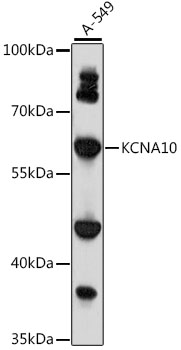Signal Transduction Antibodies 2
Anti-KCNA10 Antibody (CAB15681)
- SKU:
- CAB15681
- Product Type:
- Antibody
- Reactivity:
- Human
- Host Species:
- Rabbit
- Isotype:
- IgG
- Antibody Type:
- Polyclonal Antibody
- Research Area:
- Signal Transduction
Description
| Antibody Name: | Anti-KCNA10 Antibody |
| Antibody SKU: | CAB15681 |
| Antibody Size: | 20uL, 50uL, 100uL |
| Application: | WB |
| Reactivity: | Human |
| Host Species: | Rabbit |
| Immunogen: | Recombinant fusion protein containing a sequence corresponding to amino acids 1-125 of human KCNA10 (NP_005540.1). |
| Application: | WB |
| Recommended Dilution: | WB 1:500 - 1:2000 |
| Reactivity: | Human |
| Positive Samples: | A-549 |
| Immunogen: | Recombinant fusion protein containing a sequence corresponding to amino acids 1-125 of human KCNA10 (NP_005540.1). |
| Purification Method: | Affinity purification |
| Storage Buffer: | Store at -20'C. Avoid freeze / thaw cycles. Buffer: PBS with 0.02% sodium azide, 50% glycerol, pH7.3. |
| Isotype: | IgG |
| Sequence: | MDVC GWKE MEVA LVNF DNSD EIQE EPGY ATDF DSTS PKGR PGGS SFSN GKIL ISES TNHE TAFS KLPG DYAD PPGP EPVV LNEG NQRV IINI AGLR FETQ LRTL SQFP ETLL GDRE KRMQ FFDS M |
| Gene ID: | 3744 |
| Uniprot: | Q16322 |
| Cellular Location: | Membrane, Multi-pass membrane protein |
| Calculated MW: | 57kDa |
| Observed MW: | 62kDa |
| Synonyms: | KCNA10, Kcn1, Kv1.8 |
| Background: | Potassium channels represent the most complex class of voltage-gated ion channels from both functional and structural standpoints. Their diverse functions include regulating neurotransmitter release, heart rate, insulin secretion, neuronal excitability, epithelial electrolyte transport, smooth muscle contraction, and cell volume. Four sequence-related potassium channel genes - shaker, shaw, shab, and shal - have been identified in Drosophila, and each has been shown to have human homolog(s). This gene encodes a member of the potassium channel, voltage-gated, shaker-related subfamily. This member contains six membrane-spanning domains with a shaker-type repeat in the fourth segment. It is specifically regulated by cGMP and postulated to mediate the effects of substances that increase intracellular cGMP. This gene is intronless, and the gene is clustered with genes KCNA2 and KCNA3 on chromosome 1. |
| UniProt Protein Function: | KCNA10: Mediates voltage-dependent potassium ion permeability of excitable membranes. Assuming opened or closed conformations in response to the voltage difference across the membrane, the protein forms a potassium-selective channel through which potassium ions may pass in accordance with their electrochemical gradient. The channel activity is up-regulated by cAMP. Belongs to the potassium channel family. A (Shaker) (TC 1.A.1.2) subfamily. Kv1.8/KCNA10 sub-subfamily. Homotetramer. Interacts with KCN4B/POMP. Interaction with KCN4B/POMP is necessary for the modulation of channel activity by cAMP |
| UniProt Protein Details: | Protein type:Membrane protein, multi-pass Chromosomal Location of Human Ortholog: 1p13.1 Cellular Component: integral to membrane; plasma membrane; voltage-gated potassium channel complex Molecular Function:delayed rectifier potassium channel activity; intracellular cyclic nucleotide activated cation channel activity Biological Process: potassium ion transport; protein homooligomerization; synaptic transmission |
| NCBI Summary: | Potassium channels represent the most complex class of voltage-gated ion channels from both functional and structural standpoints. Their diverse functions include regulating neurotransmitter release, heart rate, insulin secretion, neuronal excitability, epithelial electrolyte transport, smooth muscle contraction, and cell volume. Four sequence-related potassium channel genes - shaker, shaw, shab, and shal - have been identified in Drosophila, and each has been shown to have human homolog(s). This gene encodes a member of the potassium channel, voltage-gated, shaker-related subfamily. This member contains six membrane-spanning domains with a shaker-type repeat in the fourth segment. It is specifically regulated by cGMP and postulated to mediate the effects of substances that increase intracellular cGMP. This gene is intronless, and the gene is clustered with genes KCNA2 and KCNA3 on chromosome 1. [provided by RefSeq, Jul 2008] |
| UniProt Code: | Q16322 |
| NCBI GenInfo Identifier: | 74739879 |
| NCBI Gene ID: | 3744 |
| NCBI Accession: | Q16322.2 |
| UniProt Related Accession: | Q16322 |
| Molecular Weight: | 57,785 Da |
| NCBI Full Name: | Potassium voltage-gated channel subfamily A member 10 |
| NCBI Synonym Full Names: | potassium voltage-gated channel subfamily A member 10 |
| NCBI Official Symbol: | KCNA10 |
| NCBI Official Synonym Symbols: | Kcn1; Kv1.8 |
| NCBI Protein Information: | potassium voltage-gated channel subfamily A member 10 |
| UniProt Protein Name: | Potassium voltage-gated channel subfamily A member 10 |
| UniProt Synonym Protein Names: | Voltage-gated potassium channel subunit Kv1.8 |
| Protein Family: | Potassium voltage-gated channel subfamily |
| UniProt Gene Name: | KCNA10 |
| UniProt Entry Name: | KCA10_HUMAN |
View AllClose







